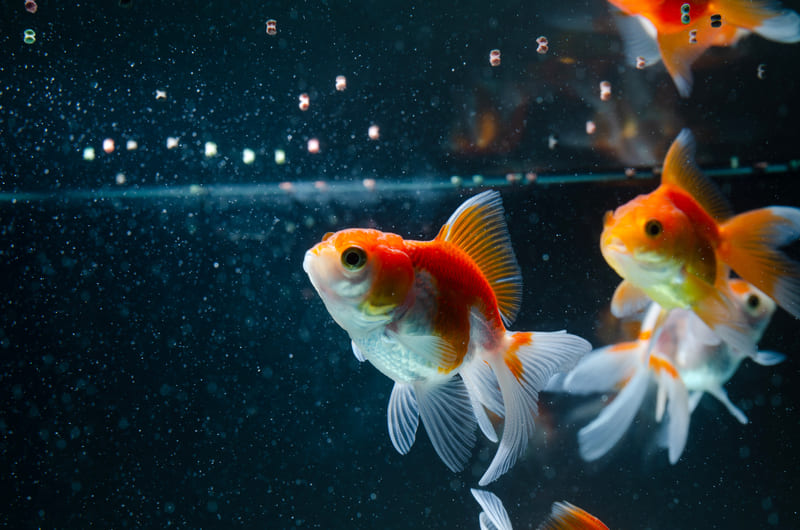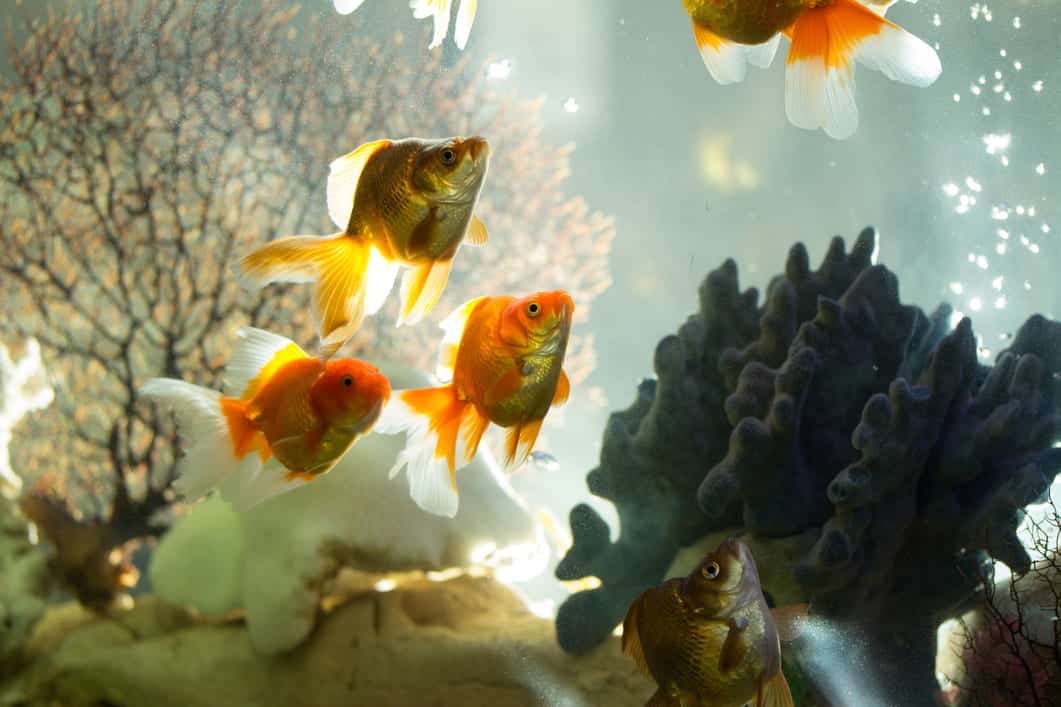Fish are sensitive creatures who can suffer majorly from temperature drops or even a slight variation in their surroundings when not in their natural environment. Having a proper schedule for important caretaking tasks like cleaning and feeding is very important. The most common household fish is the goldfish.
Since it is hard to understand a fish’s feelings and emotions, most people find it hard to understand how often we should feed them. Ideally, a goldish should be fed at least 2-3 times daily. It is important to not feed your fish more than necessary as overfeeding can cause many guttural problems.
Continue reading this article if you want to learn everything you need to know about feeding your new pet goldfish!
Do’s And Don’ts of Feeding Goldfish
Fish may require a bit of maintenance to keep as pets, but once you have got the hang of how to take care of them, they can make the best of pets. Feeding goldfish can be tricky, so we have compiled a list of crucial things to help you easily understand the basics.
1. Use High-Quality Fish Food
Using high-quality fish food which is water-friendly is very necessary. You would want a food brand that is nutritious, and will also not rot away completely in the fish tank for days. You also have to make sure that the diet is high in carbohydrates for your fish.
Although you can feed your pet the normal fish food from the market, you can also create a special mixture of goldfish flakes and granules that make a good staple diet for your goldfish.
2. Follow A Proper Feeding Schedule
This is an obvious, unspoken rule, but it is best if you have a regular feeding schedule for your tank of goldfish. Not only does it stop you from overfeeding the fish, but it is also like a daily reminder to remember your pets. You can even enhance your schedule with variety by adding different food brands to try on different days, and so forth.
With a schedule that is planned your fish will be happy too. As compared to humans, goldfish are much more regular with their schedules.
3. Remove Unwanted Food
The main reason behind the contamination of the fish tank is the extra food that remains in the water. If you just remove the excess crumbs after a feeding session, it can save your goldfish’s tank from becoming unhygienic quickly.
For this task, you can use a gravel cleaner, a cloth sieve, or whatever you are most comfortable with – as long as the tool is kept specifically for tank cleaning purposes.
NOTE: The only thing one needs to be careful of when feeding goldfish is to not overfeed your pet. Excessive eating can cause many problems like infection, indigestion, and the pollution of the fish tank.
Is It OK To Feed Goldfish Once A Day?
When goldfish are new and young, it is important that they be given food at least 2 or 3 times a day. Once they turn a year old, feeding your goldfish once a day is the ideal daily amount. Although it seems less, it is better than overfeeding your fish which causes indigestion.
The extra particles from the excess food might also litter the tank and cause the bowl or tank to become unclean.
How Long Can Goldfish Go Without Food?
Although at its maximum, a goldfish’s lifespan without food can be stretched up to two weeks, the temperature of the water and how clean it is also decided the fate of their life. Pet goldfish who are used to a feeding schedule might also develop problems if not fed for a stretch of days.
Adult goldfish have enough body mass and fat to keep them alive for a few days. Following is a table of days that a goldfish can survive without food in a certain temperature of the water.
| Water Temperature | Days Without Food |
| 0°C – 12°C (32°F – 55°F) | 1 week – months |
| 12°C – 15°C (55°F – 60°F) | 6 – 8 days |
| 15°C – 18°C (60°F – 65°F) | 5 – 6 days |
| 18°C – 21°C (65°F – 70°F) | 4 – 5 days |
| 21°C – 24°C (70°F – 75°F) | 3 – 4 days |
| 24°C – 29°C (75°F – 85°F) | 1 – 3 days |
How Often Do You Feed Goldfish In A Fish Tank?
In a tank, goldfish need to be fed at least two or three times a day. When measuring the food, a good way to decide would be to use the classic rule of thumb where you only feed an amount the same as the size of the eye of the goldfish. If you cannot determine the size, try to give just enough for the fish to finish in two minutes.
In case you use pellet-type food, you can feed two or three pellets per day for each fish. Goldfish can be very greedy and will take as much as you give them. However, overfeeding must be avoided to prevent contamination of the tank.
How Do I Know If My Goldfish Is Hungry?
There are many ways in which you can tell whether your goldfish is hungry or not. The main changes will come in their behavior. Following are some signs that your goldfish wants food.
- If your goldfish is digging around the bedding or constantly pecking at the substrate.
- Your goldfish comes up to the surface for food and is waiting there.
- Slow and lazy swimming patterns.
- Some goldfish might also show restlessness and swim differently than they usually do.
Risk of Overfeeding
The reason why there is a very short time period for your goldfish to consume its food is because the tiny particles or crumbs that are not eaten within the 2-5 minutes frame will most likely never be eaten.
There are many risks of overfeeding, most of which can be easily avoided when a proper feeding schedule is followed.
Contaminated Water
Still water is a hotspot for diseases and infection – especially when it is mixed in with old, rotting fish food in the tank. The main problem of overfeeding is the extra food that gets left behind in the tank. As it starts decaying, ammonia, nitrates and other poisonous contents might rise in your tank.
It is important that the pH levels of your fish tank are always kept between 6.8 and 7.8 as an excess of nitrites can cause the production of methemoglobin (a condition where blood is unable to carry oxygen) in fish.
Health Issues
Several diseases and health issues can be directly linked to the state of the tank that your goldfish lives in. Since your fish is not only living in the water, but is also consumed by it to survive, a dirty fish tank can cause poor digestion, rotting of the fin, fatty liver, and other sorts of infections.
Unhygienic Tank
Overfeeding leads to extra waste coming from fish food. These particles can often cause the tank to become dirty as the growth of algae and mold is inevitable. The water can also get cloudy which will eventually clog the filters of your tank and also cause your goldfish to become sick.
The extra, uneaten crumbs can also break down and cause the rise of ammonia and nitrites – eventually leading to low pH and oxygen levels. Tanks in which overfeeding is taking place might also see the rise of flatworms.
Clogging Of Fish Tank
A littered aquarium is not just bad for your fish, but your tank as well. Leftover crumbs and small food particles can clog the filter of your aquarium. It can also cause the water and the tank surrounding it to grow algae – which is not the most pleasant experience due to the putrid stench.
Tips For Feeding Your Goldfish
The following are a few tips to help you out during feeding sessions.
- Always start slow in number before slowly increasing the amount of the food.
- Use the rule of the thumb – only feed your fish what they can consume in 5 minutes.
- Buy the type of food which have the nutrition profile required by goldfish. Since they are omnivorous, they will not have a problem with any special, new food.
- Try to give different types of food to your goldfish. If you cannot find different flavors for a food brand, there is nothing wrong with buying live fish for your pet too.
Final Thoughts
While all the points mentioned in this article are valid and will help you out, it is always best to build your feeding and cleaning schedules around the habits of your pet. Hence, remember to spend a good amount of time with them. Goldfish might not be very expressive, they can recognize and distinguish humans!
We hope that this article has been helpful in providing you with the information you need about feeding goldfish.
Related Questions:
How Many Flakes To Feed A Goldfish?
You can follow the famous rule of thumb when you need to feed your goldfish – which is to give them flakes equal to that of their eye or to feed them an amount they can finish in two minutes.
How To Feed Goldfish In A Bowl?
Feeding goldfish in a bowl is similar to how you would in a tank. However, the area is small, so the most important tip is to make sure that your food is water-friendly, easy to pour, and nutritious.
When To Feed New Goldfish?
It is alright to feed your new goldfish if they are swimming visibly in your bowl in the first few hours. If it seems to be shy and hiding in your bowl, it is better to wait for them to adjust before you feed them. However, do not wait for longer than 24 hours as it is not healthy.



